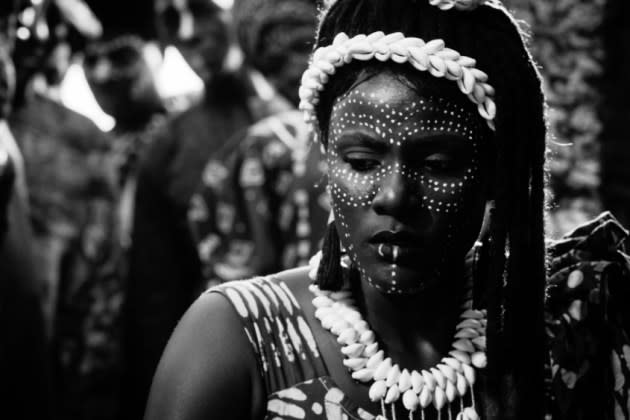‘Mami Wata’ Review: Nigeria’s Stark Black-and-White Oscar Entry Weaves Bewitching Fable with Haunting Images

Shot in dense, high-contrast black and white, writer-director C.J. “Fiery” Obasi’s “Mami Wata,” unspools like a mysterious dream. It’s both inscrutable and hypnotic, delivering indelible images while remaining narratively opaque. Billed as a “West African folklore,” its story could be taken as a straightforward fable about tradition vs. modernity and how power corrupts. But as its plot unravels, confounding layers surface beneath that easy explanation. “Mami Wata,” a Sundance discovery selected to be Nigeria’ official Oscar submission, keeps the audience entranced if never truly engaged.
Taking its cues from the legend of the female water spirit revered in that part of the world, Obasi’s story centers on Mama Efe (Rita Edochie), a medium and healer who claims to hold the keys to the all-powerful Mami Wata. The inhabitants of the isolated oceanside village shower Mama Efe with crops and gifts in an effort to win over the water deity. At home, Efe clashes with her daughter Zinwe (Uzoamaka Aniunoh) and protégé Prisca (Evelyne Ily Juhen), who think that she has taken too much advantage of the villagers. They are not believers. Matters get more complicated with the arrival of a drifter named Jasper (Emeka Amakeze), who claims to stand up for the people of the village. There’s a power struggle, allegiances shift and before long everyone is enmeshed in violence.
More from Variety
'Alhamour H.A.' Review: Saudi Arabia's Oscar Submission Is a Wannabe 'Wolf of Wall Street'
'In the Shadow of Beirut' Review: Lyrical Snapshots From a Beleaguered City's Underside
The push, pull and clash of opinion and beliefs among this quartet of characters forms the bulk of the narrative. They have philosophical differences, unshakable familial bonds and, in the case of Prisca and Jasper, budding desire. These intellectual conflicts are captivatingly expressed by the film’s languid pace. Obasi takes time to allow the actors to arrive at their emotions in due time. There are no fast cuts; rather, the camera deliberately follows the actors’ determined movements and expressive faces. Even when violence erupts, it’s treated more like choreographed dancing than action setpieces. The stark cinematography captures all this, plus the busy jewelry and striking makeup and costumes filling the frame, with consistent spectacular images.
“People like stories that make them believe,” says Prisca midway through the film, her words encapsulating why the villagers are always looking for a savior, someone or something bigger than them to enable them to continue, whether Mami Wata, Efe or Jasper. And so “Mami Wata” becomes a story about religion and how it can help give rise to colonialism and dictatorship, how even freedom fighters can end up disenfranchising their people in the quest for power. This is shown in an eerie scene that evokes the destruction power engenders — shots of soldiers yelling euphorically after firing guns. In these instances, Obasi’s storytelling reveals the themes behind the allegory.
Despite all these big ideas, Obasi keeps the focus on the four main characters, allowing the audience to glean their own takes from the narrative. However, not giving distinction to more characters, especially the villagers, leaves “Mami Wata” strictly in the realm of the fable: illustrative, alluring, but not realistic. Therein lies the film’s uniqueness and its limitations. It never manages to fly freely as fables can when they transcend their fanciful framing to make a connection with the audience.
“Mami Wata” shows Obasi as an artist commanding the technical aspects of film, particularly in their collaboration with cinematographer Lílis Soares. The images and lighting maintain the project’s bewitching nature from first frame to last. The monochrome cinematography has a spooky feel to it that holds attention — apt for a film that plays like an enchanting tall tale seeped in ancient lore. Even if narratively “Mami Wata” never fully reaches a satisfactory apex, its images remain utterly enthralling.
Best of Variety
Sign up for Variety’s Newsletter. For the latest news, follow us on Facebook, Twitter, and Instagram.
